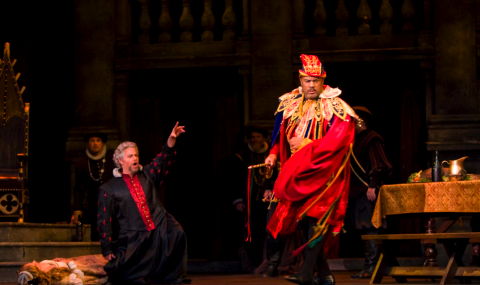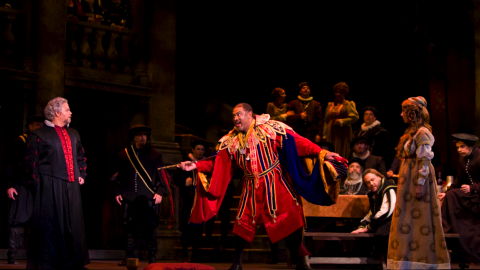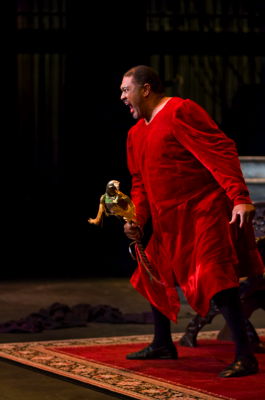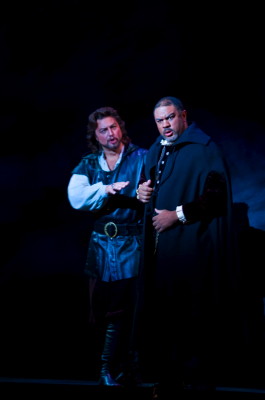|

Vibrant Life
Verdi's 'Rigoletto' at Arizona Opera,
reviewed by MARIA NOCKIN
Giuseppe Verdi based his opera Rigoletto on Victor Hugo's play, Le Roi s'Amuse which was banned in 1832. Supposedly, Hugo wrote of Francis I of France and his court, but from a historical standpoint, his work is often less than accurate. Although Francis did eventually die of syphilis at the age of fifty-two, he was not the extreme libertine that Hugo described. He was tall and had a muscular build, but he also had a huge nose that dominated his face. His nickname at court was Le Roi Grand Nez. As a teenager, he was married off to a woman not of his choosing with whom he had seven children. Although he was widowed at an early age he never married again, possibly because he preferred hunting and jousting to family life.

Christopher Hutton as Marullo and Gordon Hawkins as Rigoletto at Arizona Opera. Photo © 2008 Tim Fuller
|
In 1850, Verdi received a commission to write an opera for La Fenice, the major opera house of Venice. He first thought of Alexandre Dumas, père's, Kean, but he also read the Hugo play, after which he lost all interest in the much less emotionally involving Dumas piece. Because Hugo's play had been closed down in Paris, Verdi knew that he would have to be careful of the censors. For the important job of writing the text, he chose Francesco Maria Piave who had already written several successful libretti, including Ernani and Macbeth, for him.
From the beginning, the two men tried to assure the staging of an opera based on the Hugo play by talking to influential people in Venice. Both were aware that the scenario would have to be skillfully crafted so as to avoid anything that could cause Venetian censors to cancel it. They also realized that if this opera based on a banned play did grace the stage, its audience would be enormous. The approach to opening night was not at all smooth, but after giving the jester a new name, Rigoletto, and changing the location of the action from France to Mantua, the opera was premièred on 11 March 1851. The Venetian public loved it and accorded it wild acclaim.

Christopher Hutton as Marullo and Gordon Hawkins as Rigoletto at Arizona Opera. Photo © 2008 Tim Fuller
|
On 11 October 2008, Arizona Opera presented Verdi's Rigoletto for its opening night in Tucson. The company, which started in the southern city, now gives two performances there and four in the larger city of Phoenix. On this evening, the title role was played by veteran baritone Gordon Hawkins whose characterization was impeccable. You knew he had committed many an evil deed, but you could not help feeling sorry for him and empathizing with his love for his daughter, Gilda. Mary Wilson was a lovely young Gilda with a sweet lyric voice, but she showed few of the intricate coloratura skills that some of us expect in this role.
As the Duke of Mantua, Garrett Sorenson was a handsome playboy who produced a burnished but not overly resonant sound. He was an enticing young student with Gilda and a sophisticated lover with Maddalena. Peter Volpe was a deliciously evil, smooth voiced assassin who sang with thrust. As his alluring sister, Maddalena, Elizabeth Batton sang with a sultry voice.

Gordon Hawkins as Rigoletto. Photo © 2008 Tim Fuller
|
Stage director David Gately made the drama come to life with his use of the singers with smaller parts. Each of them: Francisco Renteria as Borsa, Christopher Hutton as Marullo, Ja Young Kuh and Robyn Rocklein as Count and Countess Ceprano, and Olga Perez as Giovanna, created vocal and physical cameos that fleshed out the story in human terms. Gately is a fine artist who works hard at interpreting the substance of the original libretto.
The Arizona Opera Chorus directed by Julian Reid was always in tune and acted as individual courtiers rather than as a static group. Conductor Richard Buckley kept the music flowing at appropriate tempi. The accompaniment was never too fast or too slow for the singers. Rigoletto is a tuneful opera and he brought the composer's intentions to vibrant life for a most grateful audience.

Peter Volpe as Sparafucile and Gordon Hawkins as Rigoletto. Photo © 2008 Tim Fuller
|
Copyright © 4 November 2008
Maria Nockin, Arizona USA

|

